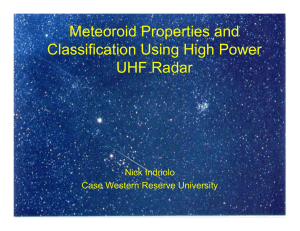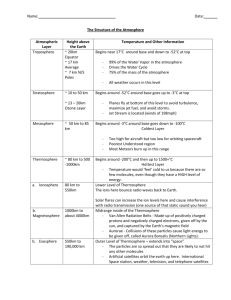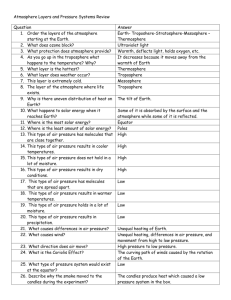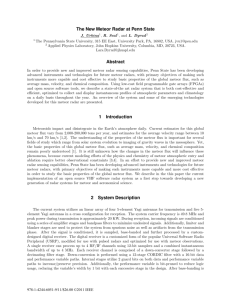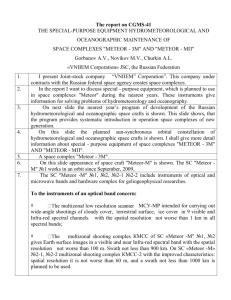Radar Sensing of the Upper Atmosphere:
advertisement
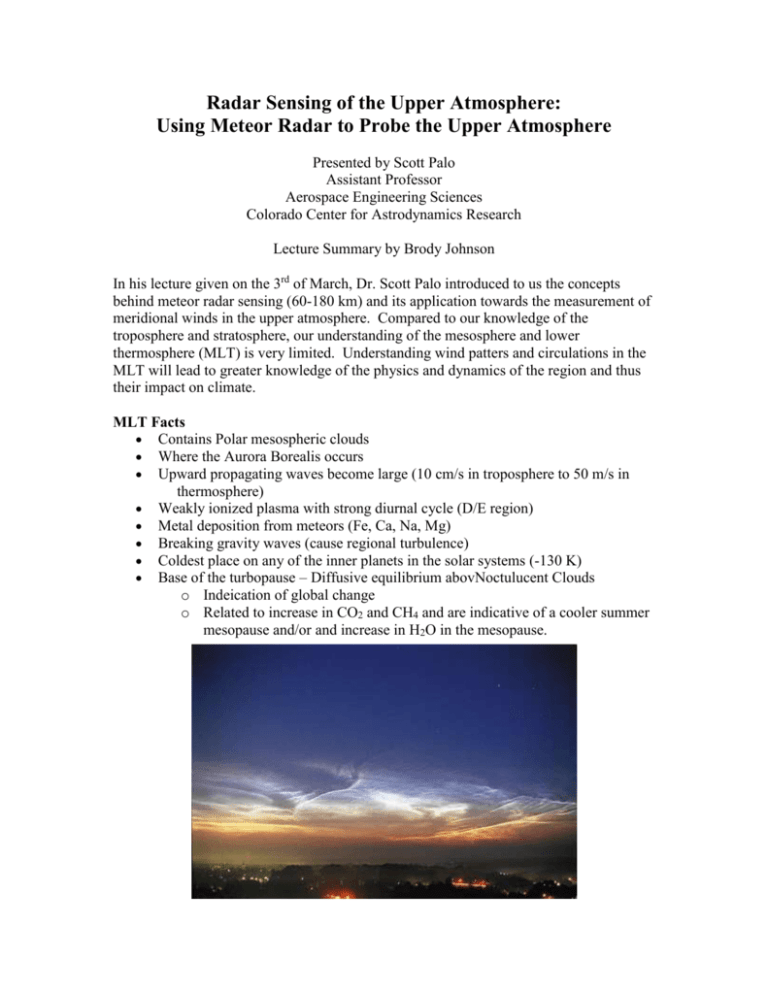
Radar Sensing of the Upper Atmosphere: Using Meteor Radar to Probe the Upper Atmosphere Presented by Scott Palo Assistant Professor Aerospace Engineering Sciences Colorado Center for Astrodynamics Research Lecture Summary by Brody Johnson In his lecture given on the 3rd of March, Dr. Scott Palo introduced to us the concepts behind meteor radar sensing (60-180 km) and its application towards the measurement of meridional winds in the upper atmosphere. Compared to our knowledge of the troposphere and stratosphere, our understanding of the mesosphere and lower thermosphere (MLT) is very limited. Understanding wind patters and circulations in the MLT will lead to greater knowledge of the physics and dynamics of the region and thus their impact on climate. MLT Facts Contains Polar mesospheric clouds Where the Aurora Borealis occurs Upward propagating waves become large (10 cm/s in troposphere to 50 m/s in thermosphere) Weakly ionized plasma with strong diurnal cycle (D/E region) Metal deposition from meteors (Fe, Ca, Na, Mg) Breaking gravity waves (cause regional turbulence) Coldest place on any of the inner planets in the solar systems (-130 K) Base of the turbopause – Diffusive equilibrium abovNoctulucent Clouds o Indeication of global change o Related to increase in CO2 and CH4 and are indicative of a cooler summer mesopause and/or and increase in H2O in the mesopause. Method of Measuring the MLT Not dense enough to fly Too dense to keep a satellite in orbit Rocket o Only previous method of direct measurement using onboard sensors Optical Sensors o Passive: Utilize emissions from Oxygen and Hydroxide molecules and Sodium atoms Provides height integrated temperature o Active (LIDAR): Requires a laser source Provides wind and temperature with fine zonal resolution (< 1 km) Radar Basics Radar – RAdio Detection And Ranging –Originally developed during WWII for target detection Transmit a radio frequency signal –Electromagnetic wave propagates through medium –Any conductor will re-radiate EM wave (oscillation of free electrons) –Reradiated signal is received and processed Can directly measure –Range to target (time delay) –Radial velocity of target (induced Doppler shift) –Reflected signal power (related to system and target parameters) Radar requires –RF source (transmitter) –Antenna system –Receiver –Data processing system Meteor Radar Basics Meteor radar sensing takes place in what is known as the Meteor Region of the atmosphere between 80 and 120 km. It is here that the molecules in the atmosphere become dense enough to produce frictional heating, which causes an incoming particle to ablate, or convert from a solid into plasma. This produces an ionized trail of electrons, which reflect incoming radiowaves. The ionized trial is carried along by the atmospheric winds. By monitoring the drift of the trial with time calculations can be made about the wind direction and speed. Since billions of particles the size of a grain of sand or smaller enter the earth’s at a velocity between 10 and 70 km/s atmosphere every day, a nearly continuous record of MLT winds can be collected. Conclusions By measuring a reflected radio signal off their tails, meteors can be effectively used to measure meridional winds in the mesosphere and the lower thermosphere (MLT). Due to the regularity of incoming meteors into the earth’s atmosphere, such a method provides a nearly continuous record of upper atmosphere winds and allows conclusions to be draw on atmospheric forcings and global change. And since the system is selfsustaining, the majority of the cost is in the initial capital, which is relatively inexpensive (usually between $50-100,000).

